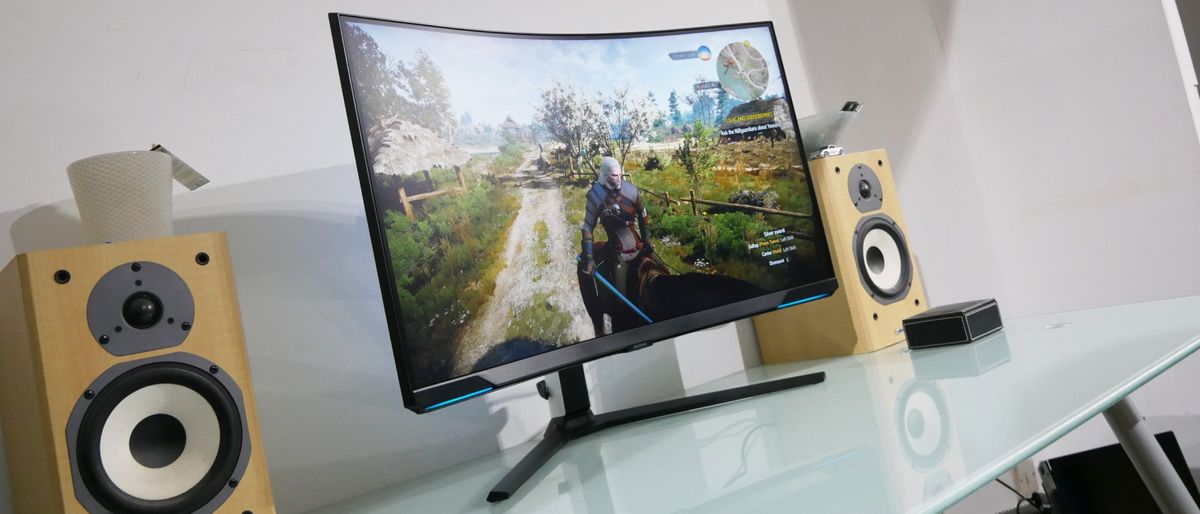12DOVE Verdict
The Samsung Odyssey Neo G8 is a mini-LED uber monitor, but one that is flawed and fantastic in almost equal measure.
Pros
- +
Super quick response times
- +
Crazy high refresh for 4K
- +
Mini-LED backlight is sometimes spectacular
Cons
- -
Mini-LED backlight is also flawed
- -
No USB-C connectivity
- -
Not exactly cheap
Why you can trust 12DOVE
If the new Samsung Odyssey Neo G8 even comes close to being the sum of its impressive parts, this is going to be one heck of a gaming monitor. This 4K beauty runs at up to 240Hz refresh, packs a mini-LED backlight with 1,196 zones, can hit 2,000 nits of brightness, and achieves 1ms response times.
Of course, numbers like that don't come cheap. However, at $1,299, or £1,300 in the UK, the Neo G8 perhaps isn't quite as pricey as it could have been. Easily affordable it ain't. But if it delivers an experience that delivers on those specs, it might still add up as a long-term investment as a top gaming monitor or 4K gaming monitor.
Also worthy of your consideration is the relatively tight 1000R curve of the Neo G8's VA panel. Curved gaming screens aren't for everyone and that's especially true of this 32-inch 16:9 aspect screen. On the G8's much bigger 49-inch sibling, the Samsung Odyssey Neo G9, a gargantuan ultrawide monitor, the wrap-around thing really works. On this smaller, more conventionally proportioned scale, it's more debatable. You might also factor in the G8's lack of USB-C connectivity. For sure, the idea of single-cable laptop connectivity is less of an immediate consideration for gaming than general computing. But at this price point, it remains a conspicuous omission.
Design & Features
Anyone familiar with the daddy of Samsung Odyssey monitors, the Neo G9, will immediately recognise the Samsung Odyssey Neo G8. It sports exactly the same curved gaming monitor design language including a mix of black and glossy white plastics, plus an RGB LED lighting system with Samsung's signature glowing ring on the rear where the stand clips into the display.
It looks properly premium, to be sure. However, the actual build quality doesn't feel all that robust. Give the screen a light push and it will rock back and forth. It's not exactly catflap-in-a-tornado, but it's less stable than you might expect at this price point.
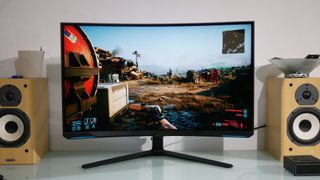
Sticking with the negatives, the aforementioned lack of USB-C connectivity stings a bit, too. It's true that USB-C power delivery currently tops out at 100W. That's not sufficient to keep a proper gaming laptop fully juiced. But at this price point, it's reasonable to expect a screen that boasts pretty broad bandwidth from a usability perspective. In that context, no USB-C hurts a bit.
Still, you do get both DisplayPort and HDMI interfaces. Indeed there are two of the latter in HDMI 2.1 spec and with DSC Display Stream Compression support. That allows for 240Hz operation over HDMI at the full 4K resolution of 3,840 by 2,160 pixels. Nice, not that you need 240Hz for console gaming, but those two HDMI 2.1 ports will of course do the full 4k @120Hz thing making this a great option for a PS5 monitor or Xbox Series X monitor. Add in that DisplayPort interface and you have the perfect dual-format screen for PC and console fun.
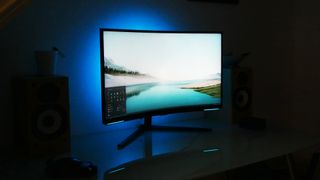
It's also worth noting that Samsung has, as ever, gone for VA rather than IPS panel tech with the Neo G8, including quantum dot enhancement for even more vibrant colours. Nearly to a man, the high-refresh 4K competition uses IPS panel tech. Typically, VA delivers better contrast and richer colours than IPS at the cost of speed. But Samsung has delivered VA monitors as quick as the best IPS screens of late, so that isn't always the case.
Of course, along with the eye-popping combination of 4K resolution and 240Hz refresh, the Neo G8's other party trick involves a 1,196-zone mini-LED backlight. It's sufficient for Samsung to claim a peak brightness of fully 2,000 nits in some circumstances. That's scary bright.
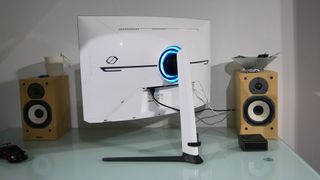
Performance
If the spec list of the Samsung Odyssey Neo G8 raises expectations, they're also tempered by the memory of the Samsung Odyssey Neo G9, another epic mini-LED powered monitor that suffered from some fairly serious issues.
For sure, the Neo G8 does some things very, very well. The pixel response is outstanding, as good as if not better than any IPS monitor. Only OLED screens like the Alienware AW3423DW are quicker. The only slightly frustrating catch is that the Neo G8 does not allow pixel overdrive and adaptive refresh at the same time, ostensibly forcing you to choose between rendering smoothness and speed. In practice, even with overdrive off, the G8 is very quick.
The 240Hz refresh also delivers super low latency provided you have one of the best graphics cards that's fast enough to deliver you high frame rates at the 4K resolution of the G8. If you have, the G8 can do things few, if any other, monitors can manage. It can deliver ultra-low lag for that critical CS:GO session and then turn on its heels and do epic detail for a Total War adventure or stunning HDR visuals in something like Cyberpunk 2077.
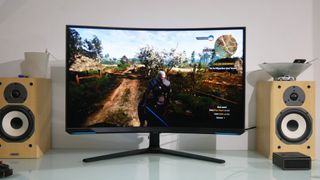
Yep, it truly is capable of stunning HDR visuals, which is not something you can say about most so-called HDR monitors. But with that capability also come problems. The G8's VA panel has outstanding inherent contrast. It's about three times better than any IPS screen in that regard. But the fancy mini-LED backlight can be frustrating.
In SDR mode on the Windows desktop, you can see the various zones adjusting to Samsung's algorithms and generally doing odd things, lighting up parts of the display and dimming others in a slightly intrusive, clunky manner. The local dimming can be disabled in SDR mode but it's absolutely essential for HDR performance.
Now, it's true that the sense of the backlight doing clunky things is far less apparent when viewing HDR content or playing games. But in our testing, the G8 never came close to the advertised 2,000 nits. It still delivered a much punchier and more convincing HDR experience than most HDR monitors. But the reality is that even 1,196 dimming zones is rudimentary compared to a 4K OLED panel where each of its eight million pixels is individually controlled for lighting. In most regards, OLED is just a whole lot better for HDR performance.
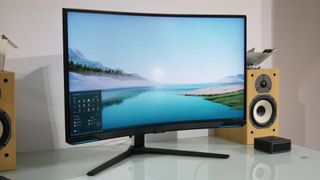
Overall - should you buy it?
The Samsung Odyssey Neo G8 delights and frustrates in equal measure. That 240Hz and 4K combo is one heck of a party trick and means this is one of the few monitors that can cope with proper hair-trigger online gaming and do justice to eye candy-orientated games that thrive on lots of pixels and true HDR capability. That's quite a package.
The problem is that even the most advanced mini-LED backlight, which is what the Neo G8 offers, is a bit clunky compared to the per-pixel lighting of an OLED panel. And when you're paying well over $1,000 / £1,000 any kind of clunkiness is hard to accept. In the end, this kind of screen tech feels like a short-term experiment while we wait for OLED or microLED to go mainstream in the monitor market. The lack of USB-C connectivity grates a little, too.
Despite all that, the Neo G8 is still a stellar gaming monitor if you want one screen to do it all - PC gaming, console gaming, and some boring stuff in Windows on the side. On that note, we're not totally convinced that the curved screen really makes sense on a conventional 32-inch 16:9 monitor like this. But it's not a deal breaker either. Just a little bit of a distraction. All of this makes the Samsung Odyssey Neo G8 fantastic and flawed in almost equal measure.
How we tested the Samsung Odyssey Neo G8
Modern gaming monitors are incredibly complex. Factors to consider include everything from colour coverage and pixel response, to refresh rates, adaptive sync, local dimming algorithms, latency, and more. Features like the configurability of overdrive settings and connectivity can really make a difference for gaming, too. But while objective measurements are important, it's the subjective experience that ultimately matters. How do all those numbers translate into gaming thrills? That's what we're here to find out, and we put it through the ringer of multiple games to get accurate readings on what it's like to actually use.
You can read more about how we test gaming monitors at 12DOVE or read more about our whole approach to gaming tech in our Hardware Policy.
After 4K but want something more TV-shaped? Check out the specialist TV screens in our best gaming TV, best 120Hz 4K TVs, and best TV for PS5 and Xbox Series X guides.
A serious dissertation on the finer points of input lag and overshoot followed by a forensic examination of AI-accelerated temporal upscaling. Such is a routine day in the working life of long-time tech wordsmith, Jeremy Laird. Along with GamesRadar, Jeremy’s 15-year back catalogue includes a host of tech and gaming outlets, including TechRadar and PC Gamer, not to mention contributions to mainstream media from the Independent to the Evening Standard. Complimenting Jeremy’s debilitating addiction to all kinds of digital hardware, he is also afflicted by an obsession with and a significant occupational sideline in cars and automotive technology.

This cozy farming sim is just a sleepy frog that idly grinds on your desktop all day - and it's the best $4 I've spent in ages

Rockstar Games co-founder and GTA 5, Red Dead Redemption 2 writer Dan Houser's new studio shows off its "story-driven action-comedy"

The Pokeball Plus cemented my appreciation of the Nintendo Switch, I just hope the Switch 2 carries on the tradition of weird and wonderful accessories
